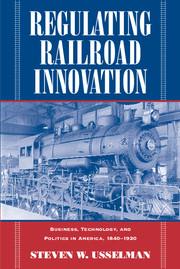Book contents
- Frontmatter
- Contents
- List of Illustrations
- Preface and Acknowledgments
- Introduction
- Part I ASSEMBLING THE MACHINE, 1840–1876
- Part II RUNNING THE MACHINE, 1876–1904
- 4 Patent Remedies: Politics, Jurisprudence, and Procedure
- 5 Mastering Technology, Channeling Change
- 6 Standardizing Steel Rails: Engineered Innovation
- 7 Engineering Enshrined
- Part III FRICTION IN THE MACHINE, 1904–1920
- Epilogue: The Enduring Challenge of Innovation
- Index
5 - Mastering Technology, Channeling Change
from Part II - RUNNING THE MACHINE, 1876–1904
Published online by Cambridge University Press: 12 August 2009
- Frontmatter
- Contents
- List of Illustrations
- Preface and Acknowledgments
- Introduction
- Part I ASSEMBLING THE MACHINE, 1840–1876
- Part II RUNNING THE MACHINE, 1876–1904
- 4 Patent Remedies: Politics, Jurisprudence, and Procedure
- 5 Mastering Technology, Channeling Change
- 6 Standardizing Steel Rails: Engineered Innovation
- 7 Engineering Enshrined
- Part III FRICTION IN THE MACHINE, 1904–1920
- Epilogue: The Enduring Challenge of Innovation
- Index
Summary
When railroads first entered into cooperative agreements designed to undercut the patent system, they were in large measure responding to specific crises associated with particular devices. By the time those troubling cases reached their climax, however, the patent associations had come to fill a vital niche in a much broader effort by management to assert some control over railroad technology. Through a variety of measures, managers sought to take the image of technical change they had advanced in their legal arguments and secure it as an institutionalized reality. This effort involved not merely taking precautions to avoid the pitfalls of the patent system, but also developing policies and procedures necessary to sustain ongoing innovation of a more anonymous character. Managers faced with rapidly changing competitive conditions looked to channel technical efforts toward certain identifiable objectives. Steering clear of radical departures in technique that might disrupt routines, they mobilized a cadre of technical experts capable of subjecting established techniques to analyses of unprecedented rigor and thoroughness. Master mechanics at individual lines increasingly gave way to professionally trained engineers ensconced in bureaucracies capable of imposing technical standards throughout the firm. These bureaucrats looked toward trade associations and professional engineering societies as forums for encouraging sustained cooperative study of select technical problems that affected the entire industry. Through coordinated analysis and action, they sought to contain innovation and render it routine.
- Type
- Chapter
- Information
- Regulating Railroad InnovationBusiness, Technology, and Politics in America, 1840–1920, pp. 177 - 214Publisher: Cambridge University PressPrint publication year: 2002



